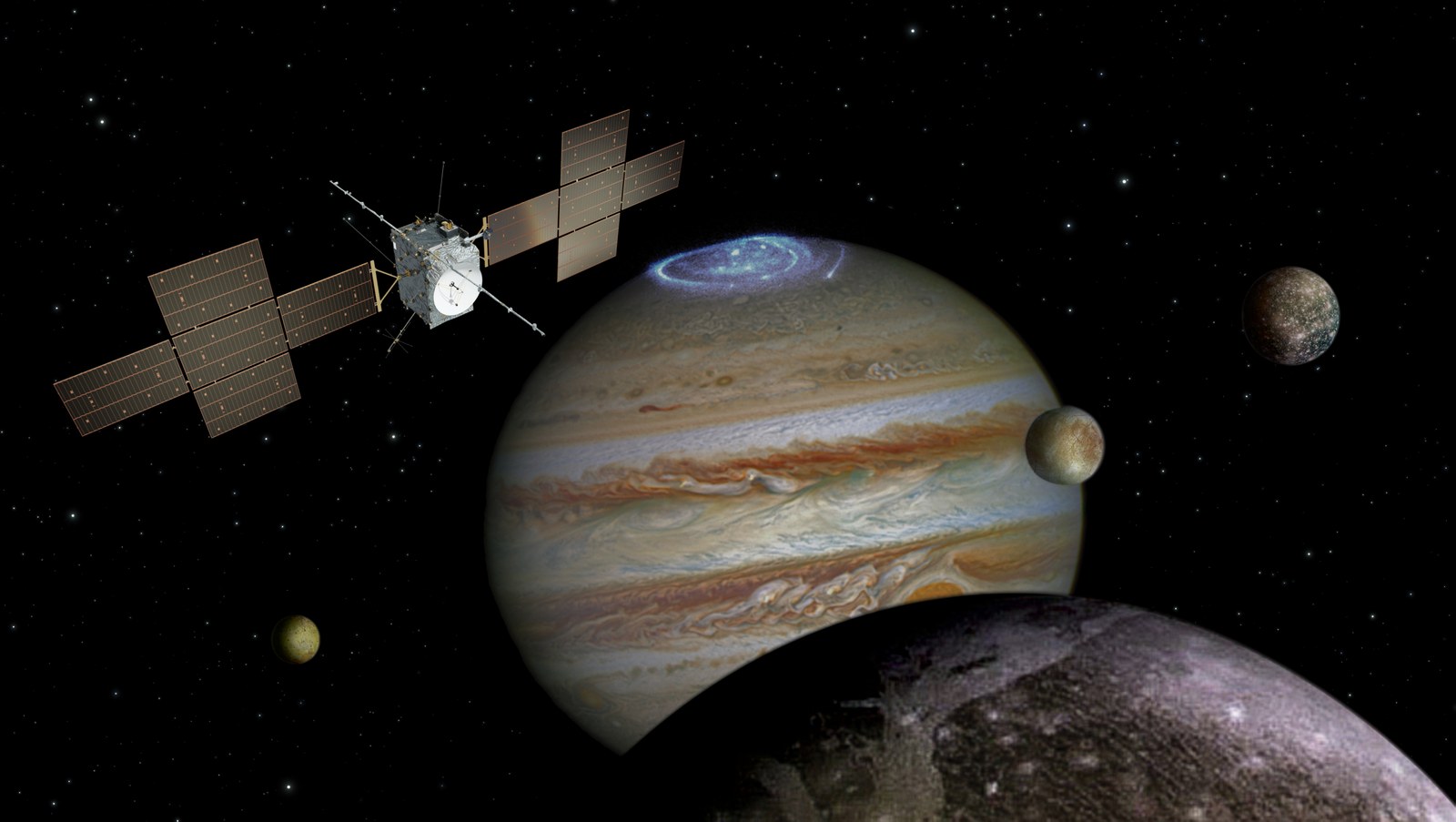JUICE

Im Jahr 2012 wählte die ESA den JUpiter ICy moons Explorer (JUICE) als erste Mission der Klasse L im Rahmen des Cosmic Vision-Programms aus. Bei dieser Mission werden zunächst Jupiter, seine Magnetosphäre und Monde aus der Umlaufbahn um Jupiter erforscht, bevor die Sonde in eine Umlaufbahn um Ganymed, den größten Trabanten im Sonnensystem, einschwenkt. JUICE wird die erste Mission sein, bei der die Sonde bei einem anderen Planeten als der Erde um einen Mond in den Orbit geht. Am 14. April 2023 um 14:14 Uhr MESZ startete die Ariane-5-Rakete mit der Raumsonde JUICE an Bord erfolgreich vom europäischen Weltraumbahnhof in Kourou. Um 15:04 Uhr MESZ wurde das Signal der Sonde vom Europäischen Raumfahrtkontrollzentrum (ESOC) der ESA in Darmstadt erfasst, und um 15:33 Uhr wurden die Sonnenkollektoren ausgefahren. JUICE ist jetzt auf dem Weg zum Jupiter. Nach ihrer Ankunft dort im Jahr 2031 wird sich die Sonde auf eine dreijährige Jupiter-Tour begeben, bei der sie zweimal in einer Höhe von 400 Kilometern an Europa und mehrmals an Ganymed und Kallisto vorbeifliegt. Schließlich wird JUICE in eine Umlaufbahn um Ganymed eintreten, und zwar in eine kreisförmige Umlaufbahn in 5.000 Kilometer Höhe und später in eine kreisförmige Umlaufbahn in 500 Kilometer Höhe für die Dauer von 132 Tage bis zum nominalen Missionsende im Jahre 2032.
Die Beiträge des DLR umfassen GALA (Ganymede Laser Altimeter, PI-Beitrag), das Kamerasystem JANUS (Jovis, Amorum ac Natorum Undique Scrutator, Co-PI-Beitrag), das unter italienischer Führung entwickelt und gebaut wurde, sowie die Definition von Instrumentenbeobachtungssequenzen und die Erstellung von hochpräzisen Umgebungskarten einschließlich digitaler Geländemodelle und geologischer Kontext- und Spektralanalysen der Oberflächen der Jupitermonde.
Mithilfe von Laufzeitmessungen unter Verwendung kurzer Laserpulse (30 Mal pro Sekunde) wird GALA die globale und lokale Topographie von Ganymed erfassen. Aus den von GALA gemessenen Gezeitenverformungen der Oberfläche lassen sich Schlüsse auf das Vorhandensein eines unterirdischen Ozeans ziehen. Dieses riesige Reservoir an flüssigem H2O tief unter der eisigen Oberfläche enthält vermutlich mehr Wasser als alle Ozeane der Erde zusammen, was Ganymed neben anderen Eismonden wie Europa, Titan und Enceladus zu einem interessanten Kandidaten für mögliche lebensfreundliche Umgebungen im äußeren Sonnensystem macht.
JANUS soll die Entstehung und die Eigenschaften von magmatischen, tektonischen und Impaktstrukturen bestimmen, diese zu den Prozessen der Oberflächenbildung in Bezug setzen, das Oberflächenalter auf globaler und lokaler Ebene eingrenzen und die Erosions- und Ablagerungsprozesse untersuchen. Globale Bilder mittlerer Auflösung von Ganymed und wichtige Teile der Oberfläche von Kallisto mit einer Auflösung von mehr als 400 m/Pixel (die Auflösung ist durch das Datenvolumen der Mission begrenzt) werden Informationen zum geologischen Kontext liefern. Das Kamerasystem verfügt über 13 panchromatische, breit- und schmalbandige Filter in Wellenlängen zwischen 0,36 μm bis 1,1 μm und bietet die Möglichkeit von stereoskopischen Bildabdeckungen. Überdies bietet JANUS die Möglichkeit, Spektral-, Laser- und Radarmessungen mit der Geomorphologie in Bezug zu setzen, um Rückschlüsse auf den geologischen Gesamtzusammenhang zu gestatten.
Hardware-Beteiligung
- GALA (Ganymede Laser Altimeter)
PI: Hauke Hussmann - JANUS (Jovis, Amorum ac Natorum Undique Scrutator, Kamerasystem)
Co-PI: Ganna Portyankina
Wissenschaftliche Beteiligung des DLR-Instituts für Planetenforschung
- GALA (Ganymed Laser Altimeter)
- JANUS (Jovis, Amorum ac Natorum Undique Scrutator, Kamerasystem)
- MAJIS (Monde und Jupiter-Bildgebungsspektrometer)
